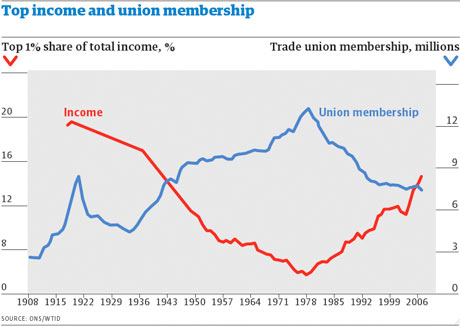When I share the graphs in this post with some of my neoliberal friends, they’re quick to bring up General Motors. The graphs demonstrate the rise and fall of union membership versus middle class share of total income in the United States and, very similarly, the rise and fall of union membership versus CEO pay in the United Kingdom. The simple lesson, of course, is that the working class achieves the best results for themselves as a collective and when they allow the capital class to destroy that power, they lose out.
First, allow me to agree with the neoliberals that it’s absolutely true… it costs more to build things in America due to minor labor laws, minimum wage laws, environmental and workplace safety regulations and so on. Most of these improvements were the result of union struggles to help provide a better life for the working class. The conservatives, inexplicably even those who are firmly entrenched in the working class, conclude that factory workers for the automakers priced themselves right out of a job. Reality, however, paints a different picture.
One thing was responsible for the collapse of Motor City and that one thing is greed. No, not greed on behalf of lifelong factory workers making sixty thousand dollars per year; the greedy folks were the stockholders and the executives who focused on “maximizing stockholder value.” You see, there are three groups of shareholders in any given company an each has its own special needs and wants:
- Executives – This includes the CEO, board members, various VP’s and such. These are the folks taking home the seven and eight figure salaries and bonuses based on key performance indicators focused on raising stock prices for stockholders.
- Stockholders – These folks are part-owners of the company, investors looking for a positive return. The stock market is a fast-paced game and these folks are not looking for long-term safe growth; they are looking for instant gratification and they hold the executives accountable.
- Employees – The workforce doesn’t have a lot of money to invest. In a display of textbook capitalism, the laborers only have their physical labor to sell in return for capital. Therefore, their interest is in long-term stability with one employer so as to continue exchanging their labor for the income needed to provide the necessities. Without long-term stability, the laborer must re-learn, re-train and start back over at the bottom of the ladder after every move (which benefits the capital class by keeping wages low).
So we’ve determined the three classes and it’s pretty obvious which two have the most power, especially when working in collusion. If the executives focus on short-term goals that cannibalize the long-term viability of the company but drive dividends higher, the stockholders wouldn’t even consider turning down executive raises. It’s a vicious circle:
- Executives cut labor, workforce loses compensation, business profits, stocks go up, stockholders reward executives
- Executives close underperforming (yet profitable) locations, part of workforce becomes unemployed, business profits, stocks go up, stockholders reward executives
- Executives outsource labor, cheapen quality of products, overlook safety issues, etc…
You get the picture. The investors get their short term boost because the executives focus on “maximizing stockholder value” at the expense of running a solid company. General Motors, for example, not only cut labor and refused to invest during boom times (neglecting long-term value for short-term payoff), they spent over twenty billion dollars in share buybacks between 1986 and 2002.
Share buybacks are a way to bribe investors by reducing the number of shares on the market, keeping share prices up artificially to keep the remaining investors happy (while helping the bought-out investors pick up some more lucrative capital gains). These actions used to be equal to about 5% of US corporate profits and skyrocketed from the start of Reaganomics through the crash, accounting for nearly 300% in 2008. Economists have said that GM would not have needed to declare bankruptcy in 2009 without the twenty billion in buybacks in previous years.
The fact is that autoworkers and their unions are not to blame for the bankruptcy at GM. It was the collusion between the executives and the stockholders that sent them to bankruptcy court. The workers were sacrificed in the neverending quest to “maximize stockholder value.” Do you know of a company doing the same thing today? I’m guessing you do.
AFTERTHOUGHT:
You know, I can’t let the union completely off the hook here. There is a real issue that needs addressed related to AFL-CIO and UAW in particular. The issue is that AFL-CIO and UAW leadership is no longer part of the collective. Through one-sided “negotiations” and self-serving motions, the leadership of these once-great unions has joined the executives in their quest to exploit autoworkers.
Presidents Richard Trumka (AFL-CIO) and Bob King (UAW) hailed Barack Obama’s recent State of the Union address in which he noted that the Big Three were back. They agreed that profits have returned to Detroit and the three American automakers were doing quite well for themselves. What these two failed to mention was the reason for the recovery. The cold, hard truth is wage scales have been cut in half and benefits have been destroyed for new autoworkers. They also fail to mention that the unions worked directly with the executives to help push these damaging changes through, fully neglecting their duties to the workers.
Oh, they also failed to mention that, as presidents of the unions, they made $294,000 and $153,000 last year, respectively. These two frauds make as much as fifteen of the autoworkers they pretend to represent. Much like the executives themselves, the union leadership in this case is working in collusion with the stockholders. Despite the short-term cuts, it’s still a long-term disaster in the making. The workers need strong, effective and non-compromising representation if they ever expect fair pay and benefits again. Right now, they’re paying union dues yet they’re still on their own.

